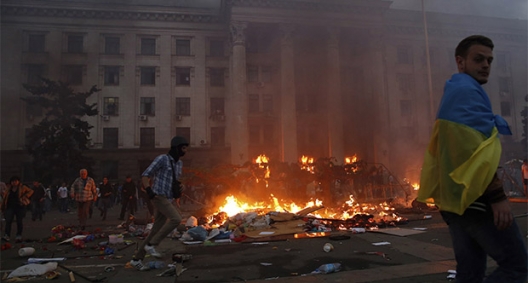 The Black Sea port of Odessa, Ukraine’s third-largest city and a coveted metropolis both for Ukrainians and Russians, became a battleground between pro-Russian militants and Ukrainians opposed to the country’s division. Accounts in Ukraine’s news media say the city’s police responded much as in the eastern Ukrainian cities hit by separatist violence so far, doing little to protect Odessa residents attacked by extremists, and instead tolerating or helping the aggressive pro-Russian groups. This widening pattern of police actions in heavily Russian-speaking zones of the country is one of the weekend’s worst pieces of news for Ukraine’s interim government.
The Black Sea port of Odessa, Ukraine’s third-largest city and a coveted metropolis both for Ukrainians and Russians, became a battleground between pro-Russian militants and Ukrainians opposed to the country’s division. Accounts in Ukraine’s news media say the city’s police responded much as in the eastern Ukrainian cities hit by separatist violence so far, doing little to protect Odessa residents attacked by extremists, and instead tolerating or helping the aggressive pro-Russian groups. This widening pattern of police actions in heavily Russian-speaking zones of the country is one of the weekend’s worst pieces of news for Ukraine’s interim government.
“The Maidan In One Day” is the title of an account of the violence by Odessa native Valeria Burlakova, writing in the news magazine Ukrainskyi Tyzhden (Ukrainian Week).
A peaceful demonstration May 2 in support of Ukrainian unity attracted many football (soccer) fans that day, writes Burlakova. The Odessa team Chornomorets was to play Kharkiv’s Metalist.
“Pro-Russian fighters attacked the Ukrainian unity demonstrators first,” writes Burlakova, “the local police followed the example of their Donetsk and Kharkiv colleagues and did not even attempt to stop them.”
Odessa residents fought back, and battles raged from street to street through the city for several hours. The combatants dug up paving blocks and quickly made Molotov cocktails to throw. The web version of her story includes video of the chaos in which shots ring, groups of people charge and fight – while others calmly record videos and take photographs.
A peculiar Odessan notion for aligning with Russia is part of the story from Ukraine’s most popular news website, Ukrainska Pravda. Its staff correspondent Kateryna Serhatskova reports from inside the pro-Russia activist camp. Serhatskova spends time with Artem Davydchenko, whose brother Anton is imprisoned in Kyiv on charges related to his own separatist campaign. (Anton Davydchenko was active in organizing protests in Odessa against the pro-European, anti-corruption campaign of last winter at Kyiv’s Maidan Nezalezhnosti, or Independence Square.)
Artem offers a notion of Odessa’s proper place between Ukraine and Russia that has a markedly softer edge than the pro-Russian talk in Donetsk, the biggest eastern city hit by separatist uprisings. Artem is willing to concede that his camp lacks a majority in Odessa, suggesting that 45 percent of residents sympathize with Russia, while 25 percent favor Ukrainian unity, and the remaining 30 percent are, he says, “couch potatoes.”
“That’s why we really have think this pro-Russian idea through, so they don’t call us separatists,” He says. Artem advocates flying both the Ukrainian and the Russian flags over administration buildings.
It’s not immediately clear whether Artem’s search for a more moderate pro-Russian identity for Odessa holds much sway with the Russia-aligned camp. Many of the combatants on May 2 chanted that Odessa is a Russian city. And the day before, at a May 1 rally marking the Soviet-era Labor Day, demonstrators waved both communist flags and the Russian tricolor, and chanted, “Odessa-Novorossiya (“New Russia”), the term used by Russian President Vladimir Putin to describe southern and eastern Ukraine.
Since 2009, Ukrainian activists have been busy instilling a sense of national unity in Odessa, writes Serhatskova. A series of Ukrainian cultural festivals have built on Odessa’s historical cosmopolitanism, which for generations included large Ukrainian, Russian and Jewish communities. This effort has created a unique Odessa style sense of patriotism, says Aleksey Cherniy, a supporter of Kyiv’s Maidan movement and of Ukrainian unity. “We showed people that the Ukrainian flag, patriotism are not nationalism.” Cherniy soberly says that pro-Ukrainian unity groups will be powerless if armed extremists enter the equation.
“If local separatists arm themselves, there will be blood and shooting. If there are no Russians, the Odessans will figure this out for themselves. The locals don’t support separatists here” he says.
One of the biggest, most compelling collections of photographs of Odessa’s eruption of violence comes from Napaki, a pseudonym for a photographer and blogger publishing on Live Journal, the Russian social network. The photos vividly portray the war-like atmosphere that reigned in Odessa on that day.
Image: A protester wrapped in a Ukrainian flag walks past a burning tent camp and a fire in the trade union building in Odessa May 2, 2014. At least 38 people were killed in a fire on Friday in the trade union building in the centre of Ukraine's southern port city of Odessa, regional police said. REUTERS/Yevgeny Volokin
